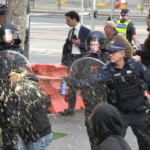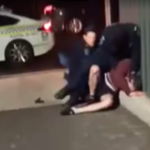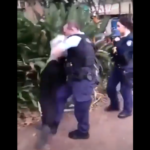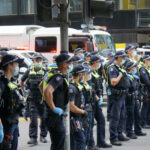Cops Gone Wild: NSW Police Officers Consistently Commit Brutality with Impunity
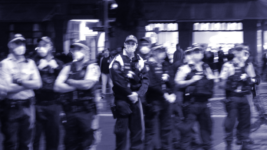
Two incidents involving NSW police that have recently captured public attention to the point of horror have revealed that officers on the beat are acting as if their uniforms place them above the law, and that standard operating procedures might read well but don’t apply on the ground, while further the expectation appears to be that officers who apply excessive force won’t be reprimanded.
These two incidents involve excessively violent use of force on a civilian under vastly different circumstances. However, both incidents are similar in that they involve officers criminally assaulting a civilian and apparently considering no consequences would be forthcoming, or that they lacked the ability to foresee the potential negative outcomes that their actions could likely result in.
The first incident to appear in the news cycle involved a male police officer alleging punching a female legal observer in the face at a 27 June 2025 protest action. The lawyer who received the punch may never see out of the right eye of which it impacted, yet the NSW police officer who threw it appears to have acted with impunity, or on the basis that there would be no consequences.
The other incident happened on 22 January 2023 and has only just gained notoriety due to the level of bastardisation involved in the police attack on a woman suffering a mental health crisis being so deplorable that a suppression order was placed upon it to apparently protect the victim from further trauma, yet as she’s since died due to unconnected circumstances, it has been lifted.
Both incidents too reveal that at least some NSW police officers are out in the field holding a belief that legislated restraints on officer conduct don’t always apply, and the breaking of protocols and the decision to apply excessive force is at officer discretion. And just like the “reserve powers” exercised by the Australian governor general, no-holds-barred emergency policing powers aren’t legislated.
Assault on a legal observer
The now infamous selfie of lawyer Hannah Thomas sitting on a hospital bed not long after a NSW police officer punched her so hard in the face that her right eye had snapped shut has successfully conveyed that state law enforcement is not necessarily there to protect the people.
Thomas attended a pro-Palestinian, antigenocide rally on Bidjigal land outside the Belmore premises of SEC Plating on 27 June, as a legal observer. The rally occurred as protesters consider the company is producing products that contribute to the global supply chain relating to the F-35 fighter jets that are currently being used by Israel in its perpetration of genocide upon the Palestinians of Gaza.
As the NSW Council for Civil Liberties explained to NSW police commissioner Karen Webb in November last year, legal observers are supposed to have a protected status, as they’re recognised as holding this under the UN Declaration on Human Rights Defenders.
Legal observers are present at protests to ensure that police aren’t violating the rights of protesters. They are not there to be beaten up by police.
The scuffling that resulted in multiple assaults by police upon the SEC Plating protesters early morning on 27 June appears to have erupted after demonstrators questioned the ability of officers to issue move-on orders, under section 197 of the Law Enforcement (Powers and Responsibilities) Act 2002 (NSW) (the LEPRA).
So, Hannah seems to have copped a punch for questioning how officers were applying the law on the ground. And due to the fact that CCTV footage only recently released to and viewed by her lawyers reveals this, the call is now for the charges police continued to press against the legal observer to be dropped and that Officer Plod who punched her has assault charges laid against him.
Bastardisation of the helpless
Former NSW police officers Nathan Black and Timothy Trautsch are currently being sentenced in relation to the almost unspeakable assault they unleashed upon a 49-year-old woman obviously suffering a mental health crisis. The extreme form of bastardisation the pair subjected her to raises questions as to why they’d been accepted onto the force, given guns and set loose in the community.
The 22 January 2023 attack, which occurred on Dharug land in the Sydney suburb of Emu Plains, took place after the officers had been called on to perform a welfare check, which means it was understood the matter involved a mental health issue, and this was made clearer as the woman was sitting naked on a nature strip in an industrial cul-de-sac, after being released from prison that day.
The woman, who suffered schizophrenia and was unmedicated, refused orders of the officers after they said she’d be taken to the hospital. The woman ran and the men in their late 20s gave chase, prior to grievously beating her, applying OC pepper spray to her genitals and her resulting wounds and only refraining, when one of them suggested there could be CCTV capturing the incident.
These NSW police officers felt emboldened enough to dehumanise and degrade this woman to such an extent while an ambulance and paramedics were already on the scene. The pair were further captured gleefully bragging to each other about the extent of the damage they’d caused to the woman, and one of them shared the footage with a friend.
Excessive use of force
Section 230 of the LEPRA permits NSW police officers to lawfully use “such force as reasonably necessary” when exercising a function, “a power, authority or duty”, that they’ve been charged with undertaking via any legislation, while section 231 of the LEPRA permits “use such force as is reasonably necessary to make” an arrest or to prevent the escape of a person after arrest.
According to the NSW Police Use of Force Manual, officers should use no more force than “is reasonably necessary”, and it should only be applied following attempts to “de-escalate a situation” or disengage from it. The document underscores that ultimately individual officers are responsible for the force they use, they must be able to justify it, and officers can’t apply force to punish.
But in terms of the recent policing incidents that have captured public awareness for all the wrong reasons, it is clear that officers did apply excessive force, it appears some of the force was used as a form of punishment, and while the officers involved are undoubtedly responsible for their behaviour, the NSW Police Force should bear some responsibility for the actions of its officers out in public.



